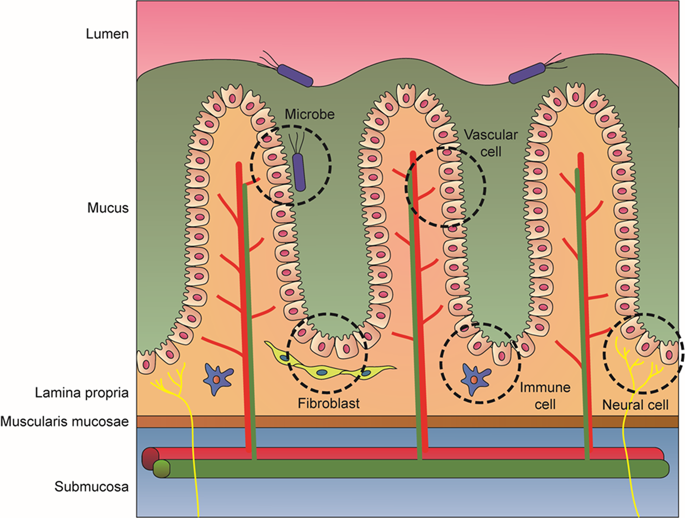当前位置:
X-MOL 学术
›
Exp. Mol. Med.
›
论文详情
Our official English website, www.x-mol.net, welcomes your
feedback! (Note: you will need to create a separate account there.)
Gastrointestinal tract modeling using organoids engineered with cellular and microbiota niches.
Experimental & Molecular Medicine ( IF 9.5 ) Pub Date : 2020-02-26 , DOI: 10.1038/s12276-020-0386-0 Sungjin Min 1 , Suran Kim 1 , Seung-Woo Cho 1
Experimental & Molecular Medicine ( IF 9.5 ) Pub Date : 2020-02-26 , DOI: 10.1038/s12276-020-0386-0 Sungjin Min 1 , Suran Kim 1 , Seung-Woo Cho 1
Affiliation

|
The recent emergence of organoid technology has attracted great attention in gastroenterology because the gastrointestinal (GI) tract can be recapitulated in vitro using organoids, enabling disease modeling and mechanistic studies. However, to more precisely emulate the GI microenvironment in vivo, several neighboring cell types and types of microbiota need to be integrated into GI organoids. This article reviews the recent progress made in elucidating the crosstalk between GI organoids and components of their microenvironment. We outline the effects of stromal cells (such as fibroblasts, neural cells, immune cells, and vascular cells) on the gastric and intestinal epithelia of organoids. Because of the important roles that microbiota play in the physiology and function of the GI tract, we also highlight interactions between organoids and commensal, symbiotic, and pathogenic microorganisms and viruses. GI organoid models that contain niche components will provide new insight into gastroenterological pathophysiology and disease mechanisms.
中文翻译:

使用细胞和微生物生态位工程化的类器官进行胃肠道建模。
最近出现的类器官技术引起了胃肠病学的高度关注,因为可以使用类器官在体外重现胃肠道,从而实现疾病建模和机制研究。然而,为了更精确地模拟体内胃肠道微环境,需要将几种邻近的细胞类型和微生物群类型整合到胃肠道类器官中。本文回顾了在阐明胃肠道类器官与其微环境成分之间的串扰方面取得的最新进展。我们概述了基质细胞(如成纤维细胞、神经细胞、免疫细胞和血管细胞)对类器官胃和肠上皮的影响。由于微生物群在胃肠道的生理和功能中发挥着重要作用,我们还强调类器官与共生、共生、病原微生物和病毒之间的相互作用。含有利基成分的胃肠道类器官模型将为胃肠道病理生理学和疾病机制提供新的见解。
更新日期:2020-02-26
中文翻译:

使用细胞和微生物生态位工程化的类器官进行胃肠道建模。
最近出现的类器官技术引起了胃肠病学的高度关注,因为可以使用类器官在体外重现胃肠道,从而实现疾病建模和机制研究。然而,为了更精确地模拟体内胃肠道微环境,需要将几种邻近的细胞类型和微生物群类型整合到胃肠道类器官中。本文回顾了在阐明胃肠道类器官与其微环境成分之间的串扰方面取得的最新进展。我们概述了基质细胞(如成纤维细胞、神经细胞、免疫细胞和血管细胞)对类器官胃和肠上皮的影响。由于微生物群在胃肠道的生理和功能中发挥着重要作用,我们还强调类器官与共生、共生、病原微生物和病毒之间的相互作用。含有利基成分的胃肠道类器官模型将为胃肠道病理生理学和疾病机制提供新的见解。











































 京公网安备 11010802027423号
京公网安备 11010802027423号